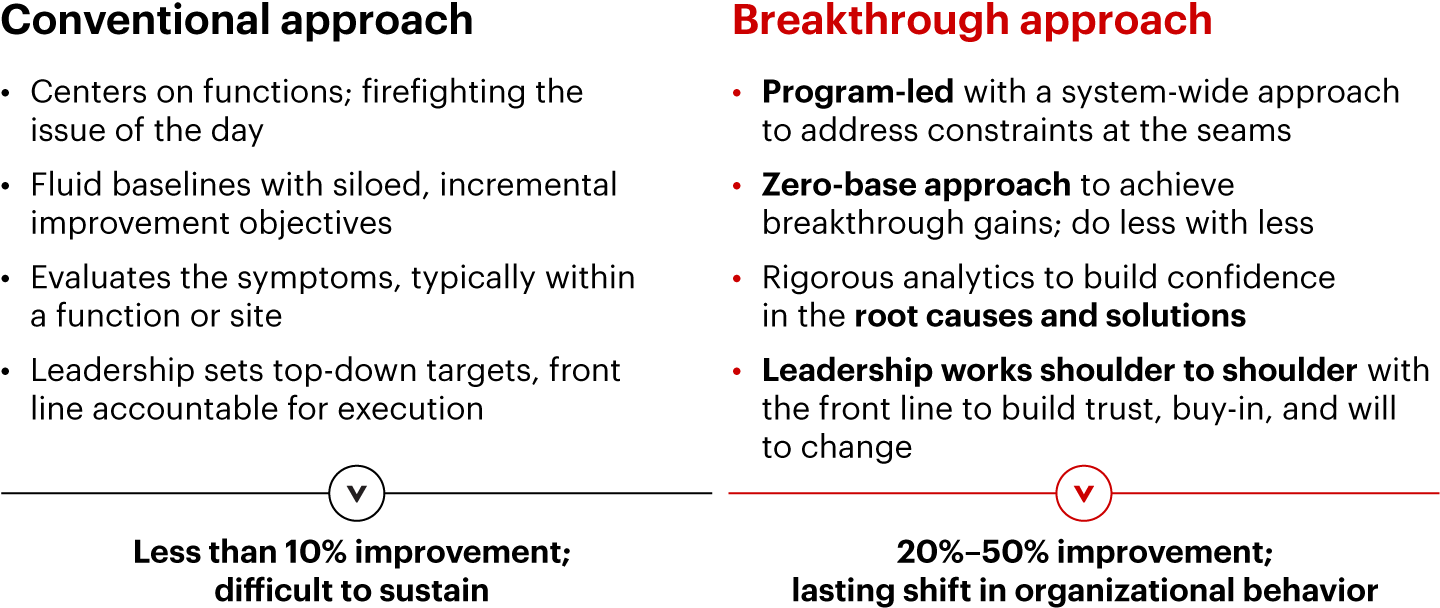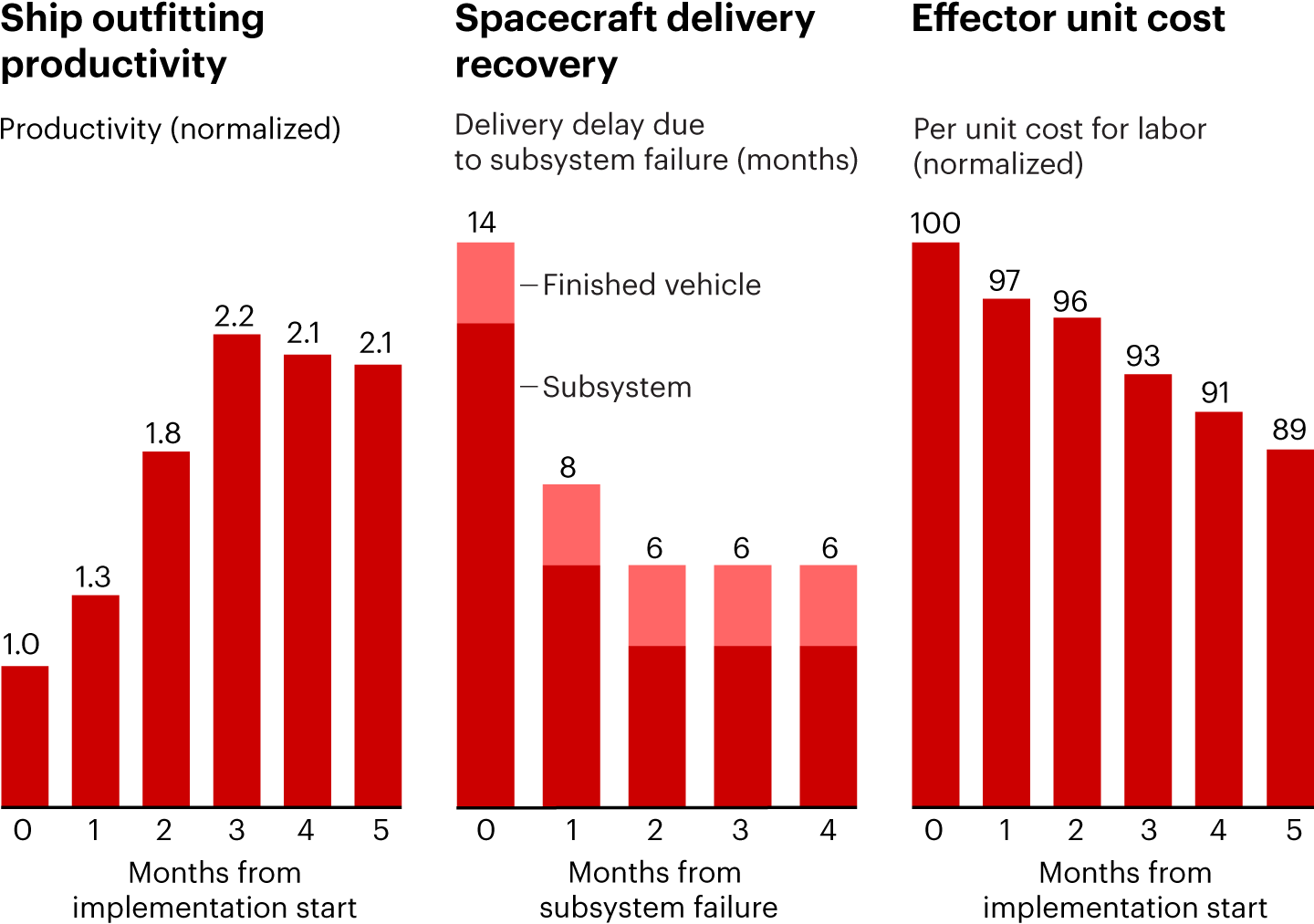Brief
 }
}
At a Glance
- US aerospace and defense program cost overruns have surged to almost $46 billion while delivery timelines have grown from 8 years to 11 years.
- A recent US administration executive order requires the Department of Defense to review major programs that are 15% or more behind schedule or above cost for possible cancellation.
- Companies using a different approach to program performance have cut program unit costs by up to 30% and compressed delivery timelines up to 50%.
- Rethinking program performance can boost company operating margins by 200 basis points or more and unlock tens of billions of dollars of savings across major defense programs.
It’s a pivotal moment for the defense industry. Global demand for defense capabilities is surging—fueled by geopolitical instability and rising military budgets. But many program executives are struggling to deliver.
Between 2020 and 2023, major US defense acquisition programs had racked up nearly $46 billion in cost overruns while average delivery timelines increased from 8 years to 11 years. Some of the largest contractors have taken $17 billion in program write-downs over the past three years. With a new executive order now requiring the US Department of Defense to scrutinize major programs that are 15% or more behind schedule or over budget, the pressure is mounting.
But the performance gap isn’t just a threat; it’s a window of opportunity. Demand continues to outpace capacity across critical defense sectors. Nations are racing to rebuild depleted stockpiles and field next-generation systems. US defense contractors’ foreign military sales surpassed $115 billion in 2024, more than triple the level of 2021, as countries around the world continue to increase their defense budgets.
For companies that rethink how they run programs, the potential upside is significant: a boost to margins of 200 basis points or more. Defense departments also stand to free up billions of dollars in savings that they can use to buy additional systems or invest in new capacity. To tap the opportunity, however, single-digit efficiency gains are inadequate: Defense companies need a 20% to 50% improvement in program performance.
Those that move first (and boldly) will do more than fix their current programs; they’ll free up capacity, win more business, and gain a competitive edge in a fiercely competitive market. And as they improve customer satisfaction, they’ll have a better shot at competing with well-funded disrupters that increasingly are winning key program competitions (e.g., Collaborative Combat Aircraft).
Why traditional approaches aren’t working
Conventional performance improvement efforts usually produce single-digit, short-lived gains. They tend to optimize existing inefficient processes and rarely remove unnecessary work. Traditional methods typically fail to address the root causes of underperformance, instead focusing on the symptoms.
The biggest constraints to improving performance lie within the seams between functions, suppliers, and programs—areas that conventional fixes rarely reach. Constraints at the seams of organizations are particularly difficult to address, in part, because they lack a single point of accountability. Changes initiated by the engineering organization, for example, may overlook the implications for manufacturing or the supply base.
Leaders tackle those constraints and achieve step-change improvements of 20% to 50% by embracing a zero-base rethink of what work is done and how it gets done (see Figure 1). And they harness deep analytics to generate conviction and commitment for bold change across the organization.


A smarter strategy
The most successful companies take a program-led, system-wide approach to improve program performance. These companies achieve unit cost reduction of up to 30% and timeline compression of up to 50%.
That magnitude of results is not easy to achieve. The most successful defense companies follow four principles (see Figure 2):
Lead with the program instead of the function. Leaders take a system-level view (cross-functional, cross-site) to resolve constraints at the seams. That’s the only way to overcome institutional silos and identify and address the root causes of costs and inefficiency, which often fall between functional and profit-and-loss boundaries.
Use a zero-base strategy to achieve breakthrough improvements. Over time, organizations build excessive layers of process and oversight that create unnecessary work delays and costs. Winning companies apply a clean-sheet strategy based on what processes or work are truly needed vs. optimizing current, inefficient processes and procedures. Ultimately, it’s about doing less with less, removing anything that is not essential, and focusing only on what drives outcomes.
Use rigorous analytics to distinguish the root causes of problems from the symptoms. Hard data and deep analytics are vital to arming the leadership team with irrefutable data and analysis to overcome entrenched resistance to change from the C-suite to the shop floor. How? Data and analytics convincingly point to the root causes of inefficiency. Once the organization is aligned, leadership teams can prioritize fewer, high-impact initiatives and avoid spreading their efforts too thinly.
Work shoulder-to-shoulder with the front line to build trust, buy-in, and quick wins for confidence. Working deep within the organization with the teams responsible for execution helps changes stick. Top-down mandates for improvement are rarely effective.


Exceptional results
Companies that follow these principles deliver significant results, despite constraints such as talent shortages or suppliers that may seem outside of their control (see Figure 3).


Note: An effector is a system or portion of a system, such as a missile or an electronic device, that is used to neutralize or defeat a battlefield target
Fonte: Bain analysisTake the case of a leading shipbuilder faced with financial losses, an inadequate build rate, and declining investor confidence. The core problem was a major shortage of talent and eroding skill sets, prompting a 50% drop in frontline productivity. Applying the four principles above helped the company dramatically accelerate its build rate despite the talent shortfall, more than doubling productivity in key areas within the first three months of execution.
A leading spacecraft manufacturer successfully deployed the same principles to address a quality issue at a sole source supplier that had prompted a 14-month launch delay and risked more than $100 million in lost revenue. The company’s bold rethink of the solution compressed the subsystem delivery delay by 50% and avoided the revenue loss.
Widespread adoption of these principles across the defense industrial base could dramatically improve deployed capabilities, accelerate time-to-mission by years, free up tens of billions of dollars to reinvest in capacity, or repurpose to more urgent needs while at the same time improving company win rates and increasing margins significantly.
A pivotal moment
Recent US administration executive orders and acutely insufficient budgets and capacity underscore the need for a new, smarter approach to program performance.
Companies that rethink program execution today will define the next era of defense achievements, earning a decisive edge in capability, performance, and growth. At the same time, they will be best positioned to provide warfighters with the capabilities they need to win on current and future battlefields.
The authors would like to thank Austin Kim, Mike Goldberg, Hugo Parkinson, and Jim Harris for their contributions to this article.